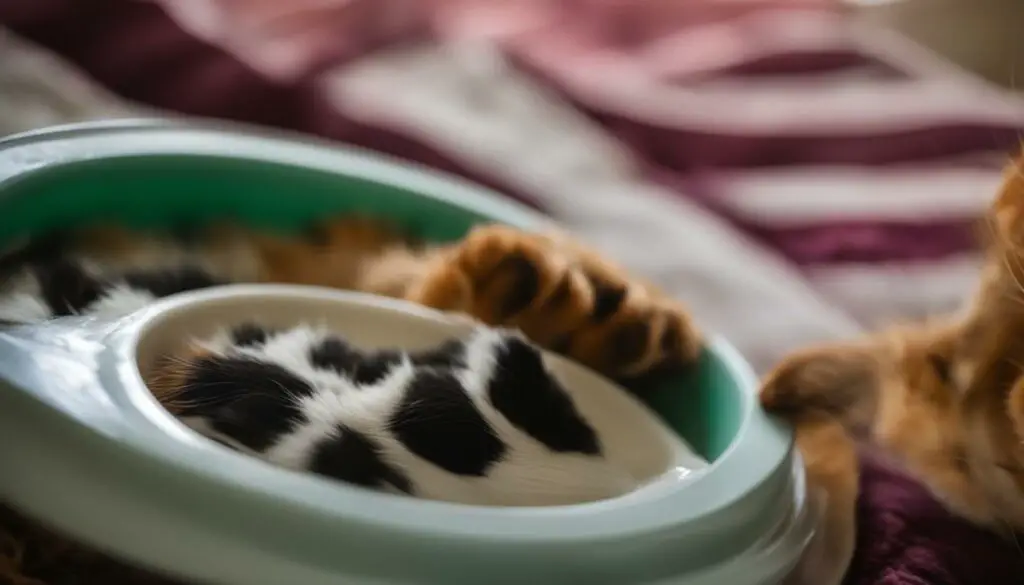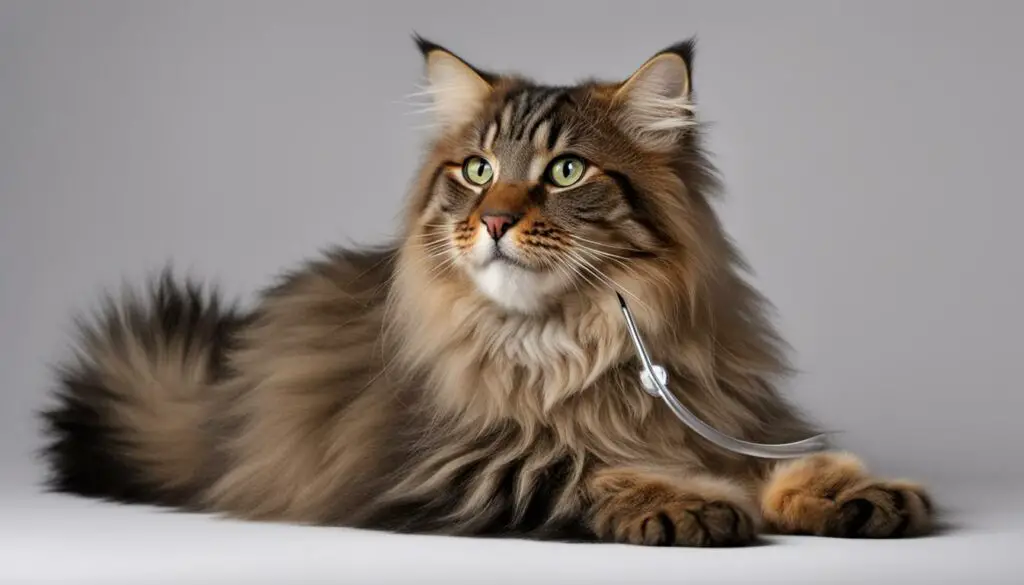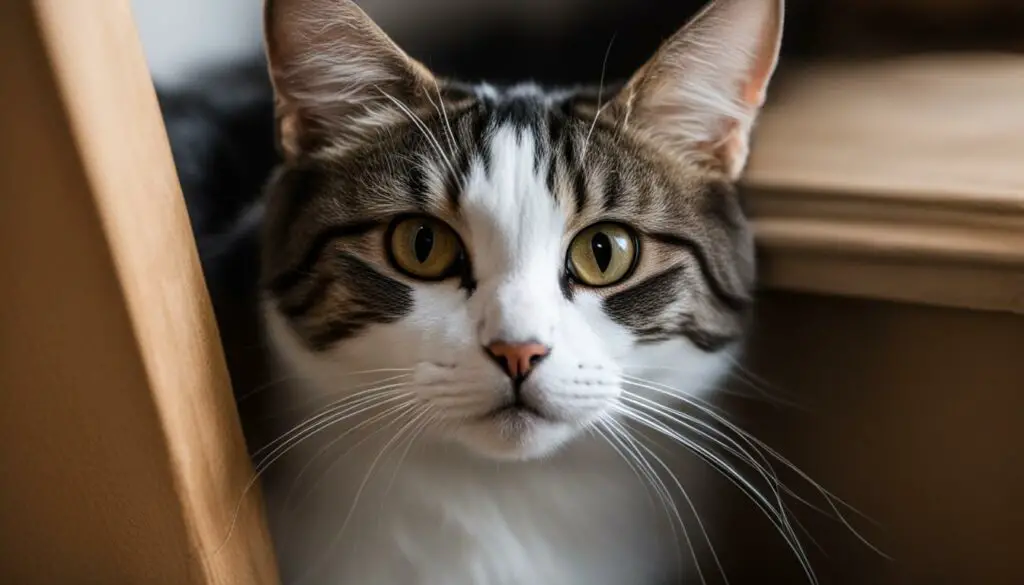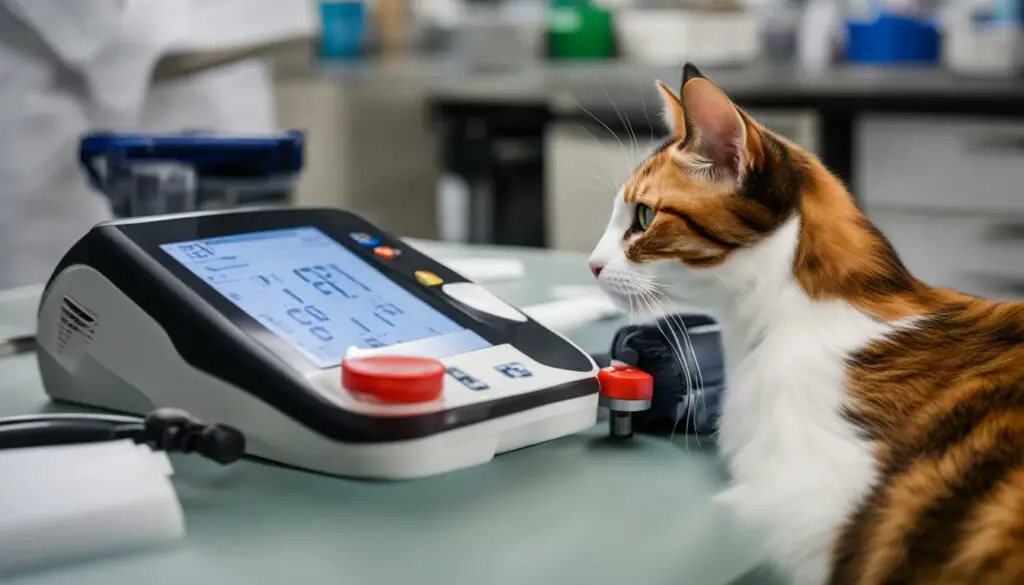Welcome to my article on understanding cat tremors when relaxed. As a cat owner, you may have noticed your furry friend experiencing involuntary movements or shaking when they are calm and at rest. This can be a concerning and puzzling behavior, but rest assured, there are reasons behind these tremors and solutions to help your cat. Let’s dive into the causes and solutions for cat tremors.
Key Takeaways:
- Cat tremors when relaxed can be caused by various factors such as medical conditions, environmental triggers, and emotional issues.
- Potential causes of cat tremors include feline cerebellar hypoplasia, toxin exposure, hypoglycemia, liver or kidney disease, infections, anxiety or fear, pain or injury, extreme body temperature, itching sensations from parasites, hyperesthesia syndrome, and seizures or other neurologic disorders.
- If you notice your cat experiencing tremors, it is important to consult with a veterinarian for proper diagnosis and treatment.
- Treating cat tremors involves addressing the underlying cause, which may include medications, supplementation, managing body temperature, and providing an environment that minimizes stress and anxiety.
- With proper care and management, cats with tremors can lead good quality lives.
Symptoms of Cat Tremors
Cat tremors can be distressing to witness, but understanding the symptoms can help you recognize when your feline companion is experiencing these involuntary movements. The most noticeable symptom of cat tremors is uncontrollable shaking, which may range from small twitches to full-body shaking. These tremors can occur while your cat is relaxed or at rest, and they can affect specific body parts or the entire body.
In addition to shaking, other common signs of cat tremors may include unsteadiness, balance issues, and difficulty walking. Your cat may appear shaky or wobbly, and their movements may seem uncoordinated. It’s important to keep an eye out for these symptoms and take note of their frequency and severity.
If you observe any of these symptoms in your cat, it is essential to seek veterinary attention. A veterinarian will be able to diagnose the underlying cause of the tremors and develop a treatment plan tailored to your cat’s specific needs. Remember, early detection and intervention can help improve your cat’s quality of life and overall well-being.

| Symptoms of Cat Tremors | Description |
|---|---|
| Uncontrollable shaking | Can range from small twitches to full-body shaking |
| Unsteadiness | Appearing shaky or wobbly |
| Balance issues | Difficulty maintaining balance |
| Difficulty walking | Uncoordinated movements |
Observing and documenting these symptoms can aid your veterinarian in diagnosing the cause of the tremors. Be sure to record the frequency, duration, and any factors that may trigger or worsen the tremors. This information will be valuable in developing an effective treatment plan.
Causes of Tremors in Cats
Tremors in cats can be caused by a variety of factors, including medical conditions, environmental triggers, and emotional stressors. Understanding the potential causes can help in identifying and addressing the underlying issue. Some of the common causes of feline tremors include:
- Feline cerebellar hypoplasia: This congenital condition affects the development of the cerebellum, leading to tremors and uncoordinated movements.
- Toxin exposure: Certain substances, such as permethrins, avermectins, amphetamines, and bromethalin, can cause tremors in cats when ingested or applied.
- Hypoglycemia: Low blood sugar levels can trigger tremors in cats, especially in kittens or those with diabetes.
- Liver or kidney disease: Dysfunction in these organs can disrupt the normal functioning of the nervous system and result in tremors.
- Infections: Diseases like toxoplasmosis, tetanus, and FIP can cause tremors in cats as a result of neurological complications.
- Electrolyte imbalances: Abnormal levels of electrolytes, such as sodium, potassium, and calcium, can affect nerve conduction and lead to tremors.
- Anxiety or fear: Cats experiencing heightened anxiety or fear may exhibit tremors as a physiological response to stress.
- Pain or injury: Physical discomfort or trauma can trigger tremors in cats as a protective mechanism or in response to nerve damage.
- Extreme body temperature: Both fever and hypothermia can induce tremors in cats, affecting their thermoregulation and nervous system.
- Parasites and itching sensations: Infestations with external parasites like fleas or mites can cause cats to experience tremors due to intense itching or irritation.
- Hyperesthesia syndrome: This condition is characterized by extreme sensitivity to touch, which can lead to muscle spasms and tremors.
- Seizures and neurologic disorders: Epileptic seizures and other neurologic conditions can result in tremors as part of their symptom presentation.
These are just a few examples of the potential causes of tremors in cats. It’s important to consult with a veterinarian for a proper diagnosis and tailored treatment plan based on the specific circumstances of your cat.

| Cause | Symptoms | Treatment |
|---|---|---|
| Feline cerebellar hypoplasia | Unsteady or wobbly gait, lack of coordination | Supportive care, physical therapy |
| Toxin exposure | Tremors, weakness, vomiting | Decontamination, supportive care |
| Hypoglycemia | Tremors, weakness, disorientation | Correction of blood sugar levels, dietary management, medication if necessary |
| Liver or kidney disease | Tremors, jaundice, increased thirst and urination | Treatment of underlying disease, diet modification, medication |
| Infections | Tremors, fever, lethargy | Antibiotics, antiviral drugs, supportive care |
How Veterinarians Diagnose Tremors in Cats
Diagnosing tremors in cats requires a systematic approach that involves gathering a complete history, conducting a physical examination, and performing diagnostic tests. As a veterinarian, I utilize various tools and techniques to pinpoint the underlying cause of a cat’s tremors.
During the initial consultation, I will ask you detailed questions about your cat’s medical history, recent changes in behavior, and any potential exposure to toxins or injuries. These insights can provide valuable clues about the possible causes of the tremors.
Next, I will conduct a thorough physical examination, paying close attention to your cat’s neurological function, muscle tone, and overall health. I may perform specific tests to assess your cat’s reflexes and coordination, such as checking for the presence of an intentional tremor or abnormal gait.
In order to gain a more comprehensive understanding of your cat’s condition, I may recommend further diagnostic tests such as blood work, urinalysis, and imaging scans. Blood work can help identify any abnormalities in organ function or electrolyte levels, while imaging scans like X-rays, CT scans, or MRI scans can provide a detailed view of the brain, spinal cord, and other internal structures.
Tests for Cat Tremors
Here are some of the common tests used to help diagnose cat tremors:
- Blood work: This can help identify any underlying medical conditions that may be causing the tremors, such as liver or kidney disease, electrolyte imbalances, or infections.
- Urinalysis: This test can provide additional insights into your cat’s overall health and rule out any urinary tract issues that may be contributing to the tremors.
- Imaging scans: X-rays, CT scans, or MRI scans can help visualize the structure and function of the brain, spinal cord, and other internal organs, allowing for a more precise diagnosis.
Additionally, providing a video recording of your cat’s tremors can be immensely helpful in the diagnostic process. It allows me to observe the tremors firsthand and analyze their characteristics, which can provide valuable information in determining the cause and appropriate course of treatment.
By utilizing a combination of history-taking, physical examination, and diagnostic tests, I can work towards accurately diagnosing your cat’s tremors and developing a customized treatment plan that suits their individual needs.
Treatment of Tremors in Cats
Tremors in cats can be distressing, but with the right treatment and management, their impact can be minimized. The treatment approach for cat tremors depends on the underlying cause. It is crucial to seek veterinary assistance to identify the specific cause and develop an appropriate treatment plan. Here are some common treatment options:
Medications
In cases where tremors are caused by a specific medical condition, veterinarians may prescribe medications to manage the tremors. These medications can help control the underlying cause or alleviate the symptoms associated with cat tremors. The specific medication prescribed will depend on the diagnosis made by the veterinarian.
Supportive Care
If the tremors are the result of a congenital or chronic condition, supportive care may be recommended to improve the cat’s quality of life. Supportive care can include dietary modifications, physical therapy, and environmental modifications to ensure the cat’s safety and comfort.
Environmental Management
Creating a safe and comfortable environment for cats with tremors is vital. Providing low entry litter boxes, sturdy food and water bowls, and padded surfaces can help reduce the risk of falls or injuries. Additionally, reducing stress and anxiety through environmental enrichment and using calming techniques can have a positive impact on managing cat tremors.
| Treatment Options | Description |
|---|---|
| Medications | In cases where tremors are caused by a specific medical condition, veterinarians may prescribe medications to manage the tremors. |
| Supportive Care | If the tremors are the result of a congenital or chronic condition, supportive care may be recommended to improve the cat’s quality of life. |
| Environmental Management | Creating a safe and comfortable environment for cats with tremors is vital. Providing low entry litter boxes, sturdy food and water bowls, and padded surfaces can help reduce the risk of falls or injuries. |
“With the right treatment and care, cats with tremors can lead happy and fulfilling lives. By working closely with your veterinarian and implementing appropriate treatment strategies, you can help manage your cat’s tremors and improve their overall well-being.” – Dr. Smith, Veterinarian
Remember, each cat is unique, and their treatment plan may vary depending on their specific needs. It is essential to consult with a veterinarian to determine the best course of action for your cat’s tremors.

Recovery and Management of Tremors in Cats
Living with cat tremors can be challenging, but with the right management strategies, you can help improve your feline companion’s quality of life. The key focus in the recovery and management of cat tremors is to ensure their safety and comfort in their environment.
One important consideration is to provide an environment that minimizes the risk of falls or injury. This can be achieved by using low entry litter boxes, sturdy food and water bowls, and adding padding or carpet runners to high surface areas. Creating a safe and secure living space for your cat is essential.
Additionally, indoor life may be recommended for cats with chronic tremors. This limits their exposure to external stressors and potential dangers, allowing them to feel more secure in their surroundings. Enriching their living space with toys and providing mental stimulation can also help distract them from their tremors and reduce anxiety.

Supporting Your Cat’s Emotional Well-being
- Reducing stress and anxiety is crucial for cats with tremors. This can be achieved through a calm and consistent routine, establishing a safe space where they can retreat, and using pheromone diffusers or calming products as recommended by your veterinarian.
- Spending quality time with your cat, engaging in gentle play or cuddling, can help create a positive bond and alleviate their anxiety.
- Consider incorporating interactive toys that stimulate their mind and body, such as puzzle feeders or treat-dispensing toys.
Remember, each cat is unique, and what works for one may not work for another. It’s important to observe your cat’s behavior and consult with your veterinarian for personalized management strategies.
| Management Tips for Cat Tremors | Key Points |
|---|---|
| Ensure a safe environment | Use low entry litter boxes, sturdy food/water bowls, and add padding to high surface areas to minimize the risk of falls or injury. |
| Consider indoor life | Limit exposure to external stressors and potential dangers by keeping your cat indoors, where they can feel secure. |
| Enrich their living space | Provide toys and mental stimulation to distract your cat from their tremors and reduce anxiety. |
| Support emotional well-being | Reduce stress and anxiety through a calm routine, safe spaces, and pheromone diffusers or calming products. Spend quality time with your cat and engage in gentle play or cuddling. |
By implementing these management strategies and providing a supportive environment, you can help your cat with tremors live a more comfortable and fulfilling life.
Muscle Relaxants for Treating Cat Tremors
Tremors in cats can be distressing for both the cat and its owner. If your cat is experiencing tremors, one potential treatment option that your veterinarian may consider is the use of muscle relaxants. These medications aim to relax the muscles and reduce or eliminate the tremors.
When prescribing muscle relaxants for cats with tremors, veterinarians take into account the cat’s size and condition to ensure proper dosing and minimize the risk of side effects. It is crucial to consult with a veterinarian before administering any medication to your cat.
“Muscle relaxants may be used to reduce or eliminate tremors in cats. These medications aim to relax the muscles and require proper dosing based on the cat’s size and condition to minimize side effects. Consultation with a veterinarian is essential for the appropriate use of muscle relaxants.”
Some common muscle relaxants that may be prescribed for cat tremors include:
| Medication | Usage | Potential Side Effects |
|---|---|---|
| Diazepam (Valium) | Reduces muscle spasms and tremors | Drowsiness, sedation, loss of coordination |
| Baclofen | Relaxes muscles and reduces muscle spasms | Drowsiness, weakness, gastrointestinal upset |
| Methocarbamol | Relieves muscle pain and tension | Drowsiness, weakness, gastrointestinal upset |
It’s essential to follow your veterinarian’s instructions regarding the administration of muscle relaxants and any other treatments for your cat’s tremors. Regular monitoring and communication with your vet can help ensure the best possible outcome for your furry friend.

Feline Tremor Supplementation: Supporting Your Cat’s Health
If your cat is experiencing tremors, supplementation can play a vital role in providing nutritional support and addressing underlying imbalances. By restoring nutrient balance, these supplements can help alleviate tremors and improve your cat’s overall health.
Here are some supplements that may be beneficial for cats with tremors:
- Vitamin B12: This essential vitamin supports neurological health and can help reduce tremors in cats.
- Magnesium: Magnesium is involved in muscle function and can help relax muscles, potentially reducing tremors.
- Omega-3 Fatty Acids: These healthy fats have anti-inflammatory properties and may support brain health, potentially reducing tremors caused by neurological issues.
It’s important to consult with your veterinarian before introducing any supplements to your cat’s diet. They can provide guidance on the appropriate dosage and duration of supplementation based on your cat’s specific needs and health condition.
| Supplement | Potential Benefits |
|---|---|
| Vitamin B12 | Supports neurological health, may reduce tremors |
| Magnesium | Helps relax muscles, potentially reducing tremors |
| Omega-3 Fatty Acids | Anti-inflammatory properties, supports brain health |
Remember, supplementation is not a substitute for proper veterinary care. It should be used in conjunction with medical treatment and under the guidance of a veterinarian. Together, you and your veterinarian can develop a comprehensive treatment plan to help manage your cat’s tremors and improve their quality of life.
Anti-Depressants or Anti-Anxiety Medications for Treating Cat Tremors
When it comes to managing cat tremors caused by anxiety or psychosomatic factors, anti-depressants or anti-anxiety medications can play a crucial role. These medications aim to alleviate the underlying emotional issues and provide relief to cats experiencing tremors. However, it’s important to note that proper dosing and guidance from a veterinarian are essential to minimize the risk of side effects and ensure the well-being of the cat.

Anti-depressants or anti-anxiety drugs for cats are prescribed based on the individual cat’s condition and severity of the tremors. The medications work by targeting neurotransmitters in the brain, helping to regulate mood and reduce anxiety levels. Cats experiencing tremors caused by fear, phobias, or generalized anxiety can benefit from these medications.
It’s important to consult with a veterinarian before starting any medication regime. The vet will evaluate the cat’s specific needs and determine the appropriate medication and dosage. Regular check-ups and close monitoring of the cat’s response to the medication are necessary to ensure its effectiveness and address any potential side effects.
“Anti-depressants or anti-anxiety medications can be a valuable tool in managing cat tremors caused by anxiety or psychosomatic factors. These medications can help alleviate the underlying emotional issues and improve the cat’s overall well-being.”
In addition to medication, providing a calm and stress-free environment for the cat is crucial. Creating a safe space with minimal triggers and offering enrichment activities can help reduce anxiety levels and complement the effects of the medications. It’s also essential to maintain regular communication with the veterinarian to adjust the treatment plan if needed and ensure the cat’s long-term well-being.
Treatment Options for Cat Tremors Caused by Anxiety:
- Anti-depressants: Medications that regulate neurotransmitters in the brain to alleviate anxiety and improve mood.
- Anti-anxiety drugs: Medications specifically designed to reduce anxiety levels and promote relaxation in cats.
- Calm and stress-free environment: Creating a safe space with minimal triggers and providing enrichment activities to help reduce anxiety levels.
- Regular vet check-ups: Close monitoring of the cat’s response to the medication and adjustments to the treatment plan if necessary.
| Treatment Options | Description |
|---|---|
| Anti-depressants | Regulate neurotransmitters in the brain to alleviate anxiety and improve mood. |
| Anti-anxiety drugs | Specific medications that reduce anxiety levels and promote relaxation in cats. |
| Calm and stress-free environment | Create a safe space with minimal triggers and provide enrichment activities to reduce anxiety levels. |
| Regular vet check-ups | Monitor the cat’s response to medication and adjust the treatment plan if necessary. |
Irregular Body Temperature and Cat Tremors
Irregular body temperature, such as fever or hypothermia, can cause cat tremors. Fevers can result from infections or underlying illnesses, while hypothermia can occur when cats are exposed to low temperatures. Monitoring and regulating body temperature are essential in managing cat tremors.
Cats with fever-induced tremors may experience shaking as their body tries to regulate its temperature. Infections or underlying illnesses can trigger fever in cats, leading to tremors as a side effect. It’s important to monitor your cat’s body temperature and consult with a veterinarian for appropriate treatment of the underlying cause.
On the other hand, hypothermia occurs when a cat’s body temperature drops below normal. This can happen if the cat is exposed to cold temperatures for an extended period or if they suffer from a medical condition that impairs their ability to regulate body heat. Hypothermia-induced tremors are the body’s response to generate heat and maintain vital functions.
| Cause of Tremors | Effect on Body Temperature |
|---|---|
| Fever | Raised body temperature |
| Hypothermia | Lowered body temperature |
Monitoring your cat’s body temperature and providing appropriate care is crucial for managing tremors associated with irregular body temperature. If you suspect your cat is experiencing fever-induced tremors or hypothermia, seek veterinary attention to ensure their well-being.

Fear, Phobia, and Cat Tremors
I’ve seen many cases where cat tremors are induced by fear and phobias. Cats can be highly sensitive creatures, and certain triggers like fireworks, thunderstorms, or unfamiliar environments can cause them extreme anxiety. This anxiety can manifest as tremors or shaking throughout their body.
Managing anxious cats with tremors requires a gentle and patient approach. Creating a safe and secure environment is crucial to help them feel more at ease. Providing hiding spots, such as boxes or cozy blankets, can give them a sense of security during stressful situations. Additionally, using pheromone diffusers or calming sprays may help alleviate anxiety and reduce the frequency of tremors.
It’s important to remember that every cat is different, and what works for one may not work for another. If your cat experiences fear-induced tremors, consult with a veterinarian who can provide tailored advice and recommendations. They may suggest behavior modification techniques, medication, or other interventions to help manage your cat’s anxiety and reduce the occurrence of tremors.
| Managing Anxious Cats with Tremors |
|---|
| Provide hiding spots and safe spaces |
| Use pheromone diffusers or calming sprays |
| Consult with a veterinarian for tailored advice and recommendations |

By understanding the connection between fear, phobia, and cat tremors, we can take proactive steps to help our feline friends feel more secure and reduce their anxiety. With the right care and support, cats experiencing fear-induced tremors can lead happier and more peaceful lives.
Hypoglycemia and Cat Tremors
Hypoglycemia, or low blood sugar levels, can be a cause of cat tremors. This condition is more commonly observed in kittens or cats with diabetes. When a cat’s blood sugar drops below normal levels, it can lead to tremors and other symptoms. Treating hypoglycemic cat tremors involves addressing the underlying cause and providing appropriate medical intervention or nutritional support.
To manage hypoglycemic cat tremors, it is important to monitor and regulate the cat’s blood sugar levels. This may involve providing a well-balanced diet and feeding schedule, as prescribed by a veterinarian. In some cases, additional supplementation or medication may be necessary to stabilize blood sugar levels.

Regular veterinary check-ups and monitoring are crucial for cats with hypoglycemia and tremors. The veterinarian will evaluate the cat’s condition, adjust treatment as necessary, and provide guidance on managing the cat’s overall health and well-being.
Feline Tremors vs. Seizures: Managing Cat Seizures and Tremors
Cat tremors and seizures are two neurologic conditions that can cause involuntary movements in cats. While they share some similarities, it’s important to understand the differences between the two and how to manage them effectively.
Key Differences between Cat Tremors and Seizures:
| Cat Tremors | Cat Seizures |
|---|---|
| Uncontrollable shaking or trembling | Uncontrolled muscle contractions |
| Can affect specific body parts or entire body | Usuall affects the whole body |
| May occur when the cat is relaxed or at rest | Often happens during periods of heightened activity or stress |
| Tremors are usually not accompanied by loss of consciousness | Seizures are often accompanied by loss of consciousness |
Managing Cat Seizures and Tremors:
First and foremost, if your cat experiences seizures or tremors, it is vital to seek veterinary attention as soon as possible. Your veterinarian will conduct a thorough examination and may recommend various diagnostic tests to determine the underlying cause. Treatment options will depend on the specific diagnosis.
In general, managing cat seizures and tremors involves the following:
- Medication: Your veterinarian may prescribe anticonvulsant medications to help control seizures and tremors. It is essential to follow the prescribed dosage and schedule to manage the condition effectively.
- Environmental modifications: Create a safe and calm environment for your cat, minimizing potential stressors that can trigger seizures or tremors. Provide a comfortable resting space away from noise and excessive stimulation.
- Diet and nutrition: Ensure your cat is on a balanced and nutritious diet to support overall health. In some cases, dietary modifications may be recommended to manage underlying conditions contributing to seizures or tremors.
- Regular veterinary check-ups: Schedule regular follow-up visits with your veterinarian to monitor your cat’s condition, adjust medications if necessary, and ensure appropriate management strategies are in place.
Remember, each cat’s situation is unique, and a tailored approach to diagnosis and management is essential. By working closely with your veterinarian, you can provide the best possible care for your cat and help them lead a comfortable and happy life.

Conclusion
In conclusion, cat tremors can be a result of various factors, including medical conditions, environmental triggers, and emotional distress. It is crucial to identify the underlying cause of the tremors in order to provide appropriate treatment and management. Consulting with a veterinarian is essential for a comprehensive evaluation and personalized care plan for cats experiencing tremors.
With proper veterinary care and management, cats with tremors can lead good quality lives. Treatment approaches may include muscle relaxants, supplementation, and medications to address anxiety or fear. Additionally, creating a safe and comfortable environment for cats with tremors can greatly enhance their well-being. This may involve making adjustments to their living space and providing enriching activities.
Remember, if you notice your cat experiencing tremors, it is important to reach out to a veterinarian for guidance. They will be able to conduct a thorough examination, perform necessary diagnostic tests, and recommend an appropriate treatment plan tailored to your cat’s specific needs. By working closely with your veterinarian, you can help your cat manage their tremors and ensure they have the best possible quality of life.

The Importance of Veterinary Care
Veterinary care is crucial for the diagnosis, treatment, and management of cat tremors. A veterinarian will be able to provide a comprehensive evaluation of your cat’s health and determine the underlying cause of the tremors. They can also prescribe appropriate medications, recommend dietary adjustments, and offer guidance on creating a safe environment for your cat. Regular check-ups with a veterinarian will ensure your cat’s well-being and allow for any necessary adjustments to their care plan.
Conclusion
In conclusion, cat tremors can have various causes, ranging from medical conditions to environmental factors and emotional issues. It is crucial to identify the underlying cause of the tremors in order to provide appropriate treatment and management for affected cats. Consulting with a veterinarian is essential in ensuring the well-being of cats experiencing tremors.
With proper care and intervention, cat tremors can be effectively managed, allowing affected cats to lead good quality lives. Treatment options include medications, supplementation, and environmental modifications to ensure the safety and comfort of cats with tremors.
Remember, if you notice your cat experiencing tremors, it’s important to contact a veterinarian as soon as possible. Only a professional can accurately diagnose the cause of the tremors and recommend the appropriate course of action. By working together with your vet, you can help your cat live a happy and comfortable life, despite the challenges of tremors.
FAQ
What are the symptoms of cat tremors?
The most common symptom of cat tremors is uncontrollable shaking, which can affect a specific body part or the entire body. Other signs may include balance issues, unsteadiness, and difficulty walking.
What causes tremors in cats?
Tremors in cats can be caused by various factors, including feline cerebellar hypoplasia, toxin exposure, hypoglycemia, liver or kidney disease, infections, electrolyte imbalances, anxiety or fear, pain or injury, extreme body temperature, itching sensations from parasites, hyperesthesia syndrome, and seizures or other neurologic disorders.
How do veterinarians diagnose cat tremors?
Veterinarians will typically gather a complete history and perform a physical examination. They may also recommend blood work, urinalysis, X-rays, specialized tests like PCR or titers, and advanced imaging such as CT and MRI scans.
What is the treatment for cat tremors?
The treatment for cat tremors depends on the underlying cause. It may involve hospitalization and decontamination for toxin exposure, supportive care or specific medications for congenital diseases, and long-term medications or specialized diets for underlying diseases. In some cases, management focuses on ensuring the cat’s safety and comfort.
How can cat tremors be managed?
Managing cat tremors involves ensuring their safety and comfort. This can include providing an environment that minimizes the risk of falls or injury, using low entry litter boxes, sturdy food and water bowls, and adding padding or carpet runners to high surface areas. Enriching their living space with toys and reducing stress and anxiety can also improve their quality of life.
Are there medications to reduce cat tremors?
Yes, muscle relaxants may be used to reduce or eliminate tremors in cats. However, proper dosing based on the cat’s size and condition is crucial to minimize side effects. Consultation with a veterinarian is essential for the appropriate use of muscle relaxants.
Can supplementation help with cat tremors?
Yes, supplementation may be recommended to restore nutrient balance and help alleviate tremors in cats. However, a veterinarian should determine the appropriate supplementation for the cat’s specific needs.
Are there medications for anxiety-related cat tremors?
Yes, anti-depressants or anti-anxiety medications may be prescribed for cat tremors caused by anxiety. Proper dosing is crucial to minimize the risk of side effects, and a veterinarian should guide the use of these medications.
Can irregular body temperature cause cat tremors?
Yes, irregular body temperature, such as fever or hypothermia, can cause cat tremors. Fevers can result from infections or underlying illnesses, while hypothermia can occur when cats are exposed to low temperatures. Monitoring and regulating body temperature are essential in managing cat tremors.
Can fear or phobias cause cat tremors?
Yes, cats can experience tremors due to fear or phobias, such as fireworks or thunderstorms. Managing these underlying emotional issues and providing appropriate care can help alleviate cat tremors in these situations.
Can hypoglycemia cause cat tremors?
Yes, hypoglycemia, characterized by low blood sugar levels, can cause cat tremors. This condition is more common in kittens or diabetic cats. Addressing the underlying cause and providing appropriate nutrition or medical intervention can help manage hypoglycemic cat tremors.
What is the difference between seizures and cat tremors?
Seizures and cat tremors can have overlapping symptoms, making them difficult to distinguish. Proper diagnosis and treatment for seizures or other neurologic disorders are crucial in managing cat tremors associated with these conditions.
How can cat tremors be managed in the long term?
Cat tremors can be managed in the long term by ensuring their safety and comfort. This may include providing an appropriate environment, minimizing stress and anxiety, and working closely with a veterinarian to address any underlying causes or conditions.








